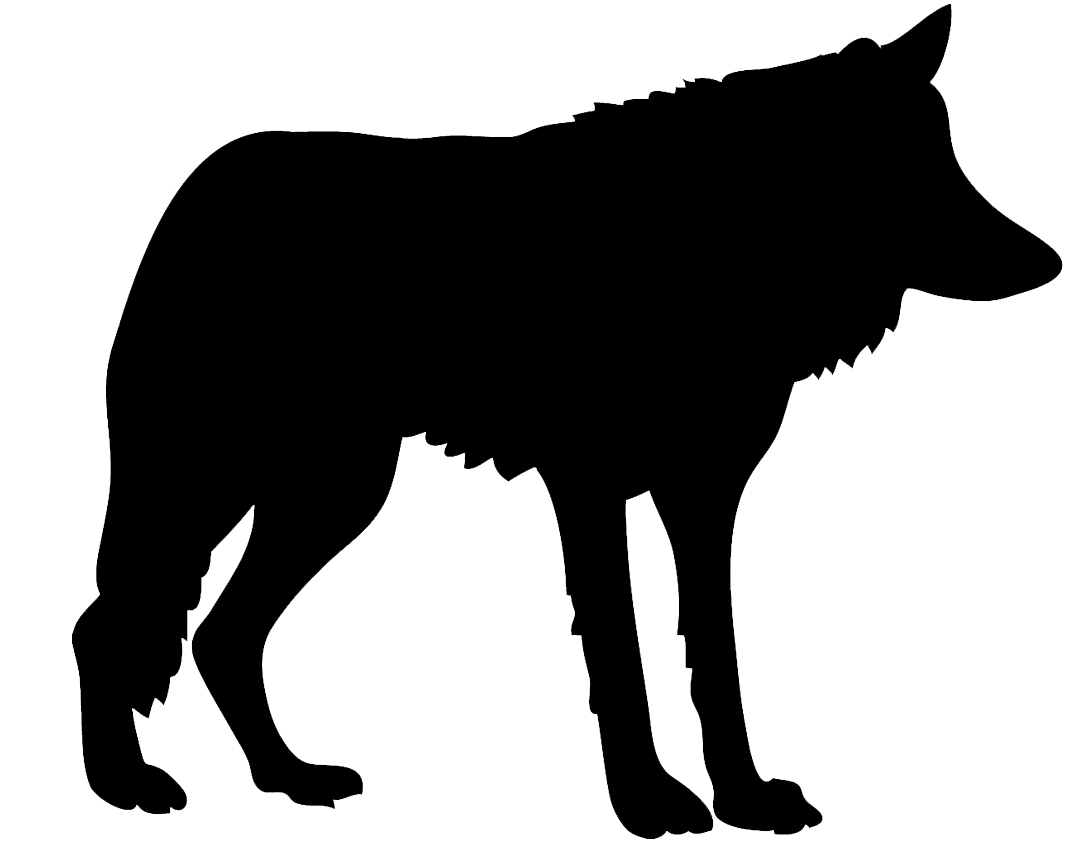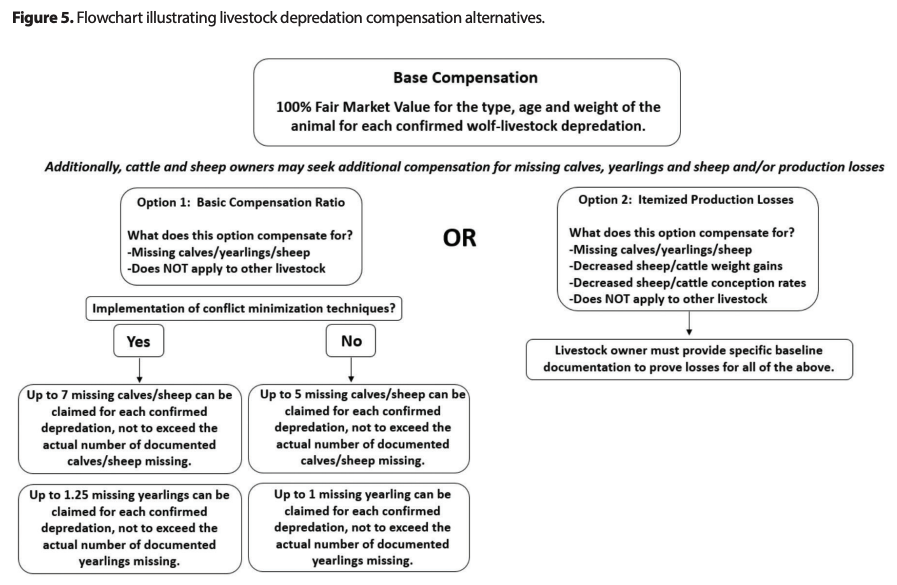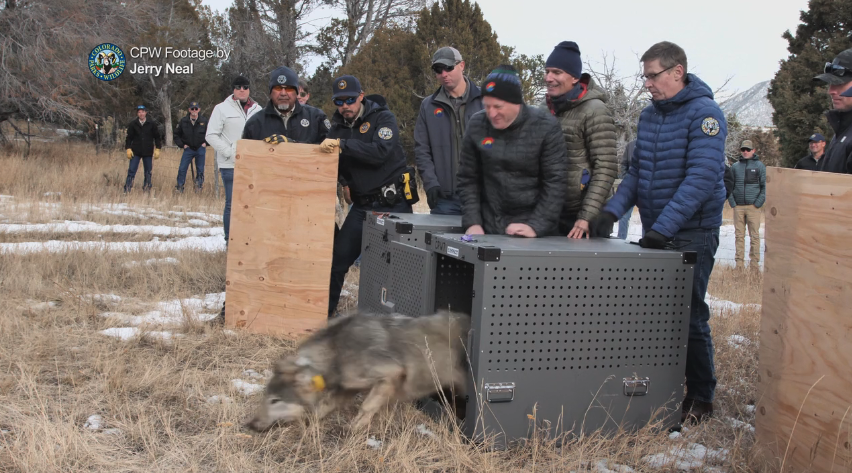GRAND COUNTY, Colo. — A calf was killed in the first confirmed report of gray wolf depredation in Colorado since the animals' reintroduction began in December 2023.
A landowner in Grand County reported finding a dead calf on the morning of April 2, Colorado Parks and Wildlife (CPW) said. Per protocol outlined in the Colorado Wolf Restoration and Management Plan, wildlife officials began conducting a field investigation in the area, said Travis Duncan with CPW. They will do this "in the same thorough and professional manner the agency has been investigating black bear or mountain lion damage to livestock," the plan reads. Those wildlife officers later confirmed the wolf kill on Wednesday afternoon.
"The results of this investigation indicated wounds consistent with wolf depredation,” said CPW Area Wildlife Manager Jeromy Huntington. “The field investigation found multiple tooth rake marks on the calf's hindquarters and neck, and hemorrhaging under the hide, consistent with wolf depredation. Wolf tracks were also found nearby."
Duncan also confirmed the wolf or wolves involved were part of the 10 animals that were reintroduced in December.
That month, The Fence Post, a nationwide agricultural newspaper, reported the first five wolves released in Colorado were from packs in Oregon that were deemed responsible for killing or injuring livestock in 2022 and 2023. When Denver7 brought this question to CPW in December, Duncan said that any wolves that live near livestock "will have some history of depredation, and this includes all packs in Oregon. This does not mean they have a history of chronic depredation. If a pack has had infrequent depredation events, they should not be excluded as a source population per the plan." He explained this more here.

Denver7 360 | In-Depth News
Grand County residents brace as gray wolf reintroduction process begins
Grand County Commissioner Merrit Linke spoke with Steamboat Radio on Wednesday, saying that the livestock owner checked on the cows early Tuesday and saw that a newborn calf had been killed, but not eaten, possibly because the mother cow "raised hell." Linke told Denver7 that the producers who owned the calf are likely feeling "everything from disappointment to heartbreaking deception to outright anger." Calves like the one killed were sold for $1,600 to $2,000 last fall or early 2024, Linke said.
In line with the Colorado Wolf Restoration and Management Plan, the livestock producer — who has not been identified — is eligible for fair market value compensation if they submit a claim, CPW said.
"CPW staff will continue contacting producers in the area, and encouraging the use of appropriate non-lethal deterrents available through the agency," CPW said.
No other details were immediately available on this case as of Wednesday afternoon.

Many ranchers are currently in the middle of their calving season, said Middle Park Stockgrowers President Tim Ritschard, who is a fifth-generation rancher. He said he was actually surprised so many months passed before a wolf made a livestock kill.
“I have friends that live in Wyoming, Idaho, and, you know, they tell stories about what's going to happen, what's happened in their areas," Ritschard said. "... It's just going to be really interesting what happens this summer, when things start moving around, we start going into the higher elevation — there's no snow around anymore and what's going to happen then?”
He said turbo fladry, or electrified fencing with flagging, is an option, but he alone would need about three miles of it. He's concerned the state does not have enough for all the producers in need.
"The reimbursement thing is a little that is tough, because yes, we might have lost a calf, but if it's a heifer calf, you know, she could have been on the operation for 10 years," he added. "How are we going to rebuild that back?... I just think if we could all work together instead of just pushing one way, you know, it'd be a little bit better.”
The Colorado Cattlemen’s Association said in a written statement that this incident "underscores the ongoing challenges faced by ranchers in managing conflicts between livestock and wildlife. Wolf presence presents significant challenges for ranchers striving to maintain the health and well-being of their livestock."
Rob Edward, on the board of directors for Rocky Mountain Wolf Project, stressed that wolves belong in Colorado and Wednesday's news about a depredation was a loss but "fully expected" to happen at some point — it's why compensation was built into Proposition 114, which voters passed in 2020 to mandate the reintroduction, he said.
"After we have a few wolves on the ground... we were going to have some interaction with livestock," he said in a Denver7 interview. “We know that there will be depredation. But we also know that there are ways to help minimize those kinds of negative encounters for ranchers.”
That includes turbo fladry, which the CPW can help deploy with the landowner, Edward said. Flashing lights are another option, as are range riders — specialized livestock herders — who are paid through proceeds from the Colorado wolf license plate. As of mid-March, sales of that plate raised about $66,000.
"It's a loss — we understand that," Edward said. "And the fact that rancher will be compensated for that loss helps but isn't a complete nullification of the conflict there. We sincerely hope that the Livestock Growers Association and the individual rancher will work with CPW to quickly deploy the measures to reduce the possibility of further depredation. That's the way that this program is going to be successful.”

While this marks the first reported attack on livestock in Colorado since 10 gray wolves were taken from Oregon and released in Colorado in December, there have been multiple conflicts over the years involving the wolves that naturally moved into Colorado, including but not limited to:
- In December 2021, officials confirmed the first wolf kill of livestock in Colorado in more than 70 years
- In January 2022, CPW reported that a domestic dog had been killed — and another was injured — by wolves in Jackson County. This same month, two domestic cows were attacked by wolves in the same county
- In October 2022, CPW investigated potential wolf attacks on livestock near Meeker, but said it found no evidence of wolves in the area
For background: As part of the state's voter-mandated reintroduction effort, CPW released its first five gray wolves on Dec. 18, 2023 at an undisclosed place in Grand County. Five more were released a few days later in Grand and Summit counties.
All 10 were collared, though CPW said on March 27 that a collar on a released gray wolf is no longer providing a signal and another collar is partially functioning and may fail soon.
CPW did not have an exact reason for the failures, Duncan said. Re-collaring the wolves with new equipment could pose "an unnecessary risk to any potential reproduction," he added. So CPW will not try to fit those two wolves with new collars.

This is all in the wake of the May 2023 approval of the Colorado Wolf Restoration and Management Plan.
That plan describes the legal requirement to provide fair compensation to livestock owners for any economic losses if their animals are injured or killed by wolves. If livestock or a guard animal is injured or killed, the wolf-livestock compensation program will pay for 100% of fair market value compensation, up to $15,000 per animal. A detailed layout of the compensation options is outlined on page 33 of the management plan here.

There is no compensation program for loss of pets or hunting dogs. Lethal control of wolves in the act of killing a pet or hunting dog, or just after the fact, is not allowed, as consistent with other game damage laws and regulations, according to the plan. In addition, under current state law, it is illegal to hunt wolves.
CPW has hired a wolf conflict coordinator to serve as the statewide expert on human-wolf conflicts, the plan reads.

Local
CPW updates on wolf reproduction, conflict minimization, community outreach
During the most recent CPW Commission meeting, Reid DeWalt, CPW’s assistant director of aquatic, terrestrial, and natural resources, said CPW will continue to set up supply houses — also called stash houses — which hold wolf depredation prevention materials that can be easily provided to producers if wolf conflicts arise, DeWalt said. As of that meeting, four were already in place and four more were planned. In addition, CPW has the ability to provide temporary conflict minimization materials to livestock owners on a case-by-case basis. This includes turbo fladry (electrified fencing with flagging) and scare devices, like shell-crackers, propane cannons, and foxlights, the management plan reads.
At the end of March, CPW released an updated map to show how the gray wolves have traveled in the past month. Below is a map from late February on the left, and the most updated map on the right.

Looking ahead, CPW will continue with the operation according to the Colorado Wolf Restoration and Management Plan, which calls for the transfer of 30 to 50 wolves to Colorado over a period of three to five years, aiming for 10 to 15 wolves from multiple packs each year.
The state announced in January that it had secured an additional 15 wolves from tribal lands in northeastern Washington to reintroduce next winter.
After that point, the reintroduction efforts will stop and CPW will monitor if the population is self-sustaining.
If you see a gray wolf, CPW asks that you fill out its wolf sighting form here. If possible, wildlife officers ask that you take photos and videos.







